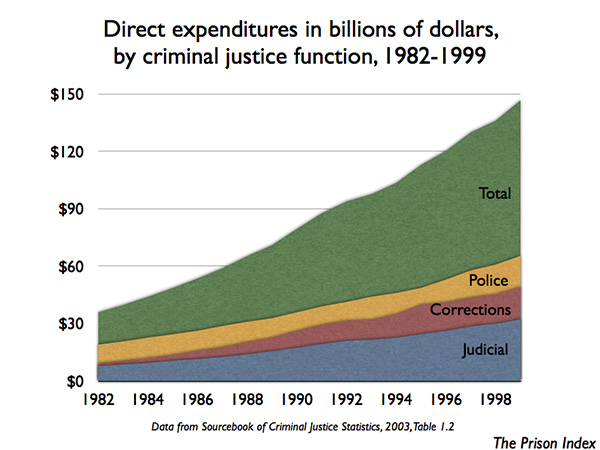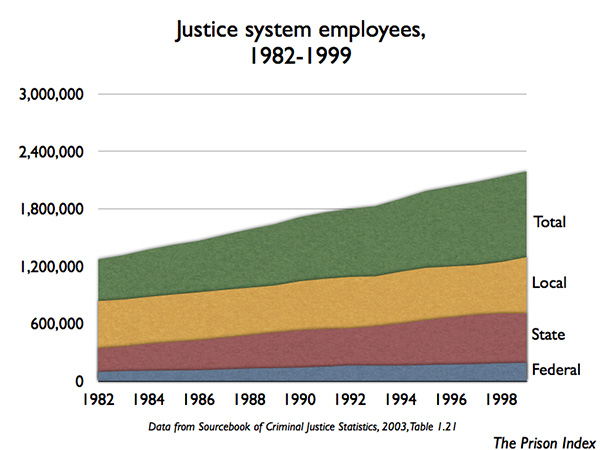Overview: Trends in the Crime Control Industry
The Crime Control Industry and the Economy
Government expenditures for "justice" have been growing at an average rate of 8.1% a year since 1982.14 A staggering $36 billion in 1982 grew 309% to $147 billion in 1999.15 Correcting for inflation, that's an increase of 145%.

While some police and judicial expenses are not for crime control, the government figures do not include the $104 billion private security industry. Criminologist Nils Christie estimated the combined size of the U.S. public and private crime control industry at $210 billion in the year 2000.16 In comparison, the U.S. Defense Department spent $281 billion in 2000, $8.6 billion less than it spent a decade prior in 1990.17 By contrast, the crime control industry grew each year an average of 8%.

As the combined total of all of its parts, the crime control industry has had a very smooth growth without the periodic changes of any particular indicator.
Factors suggesting a continued increase in the size of the crime control industry:
- There are currently a tremendous number of workers and voters dependent on the industry, and those punished by it frequently cannot vote.
- Healthy industries have no interest in stopping their own growth.
- There is little sign that the public is refusing to watch violent programming or news programs that overemphasize crime, a possible factor in "tough on crime" attitudes.
Factors suggesting a slowing of the crime control industry growth rate:
- The factors discussed above about the weakening economy and increasing public frustration with the inability of the prison experiment to address crime may restrict the industry's growth.
- Growing awareness about the impact of the media on culture and politics may reduce the effectiveness of popular culture at encouraging more punitive responses to social problems.
- Growing opposition to prison sitings by local communities is making it increasingly difficult to site new prisons.
- The size of the prison population and its concentration in Black, Latino and impoverished communities is leading those communities to end their support for law and order policies that weaken, rather than protect, their communities.
This page is an excerpt from The Prison Index: Taking the Pulse of the Crime Control Industry (April 2003) by Peter Wagner, published by the Western Prison Project and the Prison Policy Initiative.
Footnotes
14 Bureau of Justice Statistics, Justice Expenditures and Employment in the United States, 1999, Table 1.
15 Bureau of Justice Statistics, Justice Expenditures and Employment in the United States, 1999, p 1.
16 Nils Christie, Crime Control as Industry, 2000 ed, p 140.
17 Statistical Abstract of the United States 2001, Table 491.
Events
- April 15-17, 2025:
Sarah Staudt, our Director of Policy and Advocacy, will be attending the MacArthur Safety and Justice Challenge Network Meeting from April 15-17 in Chicago. Drop her a line if you’d like to meet up!
Not near you?
Invite us to your city, college or organization.



